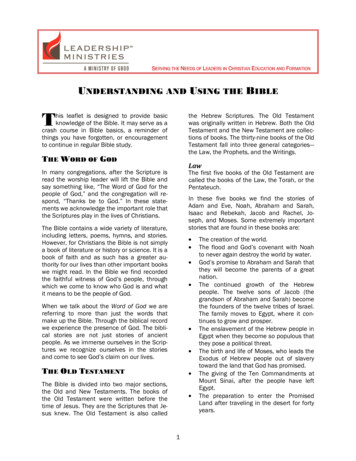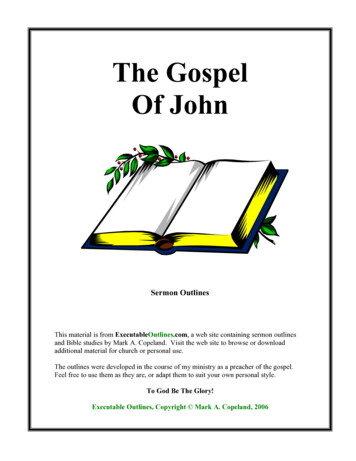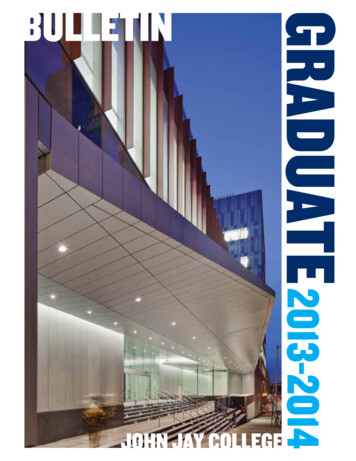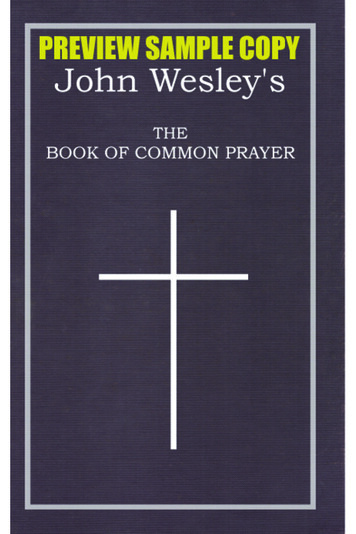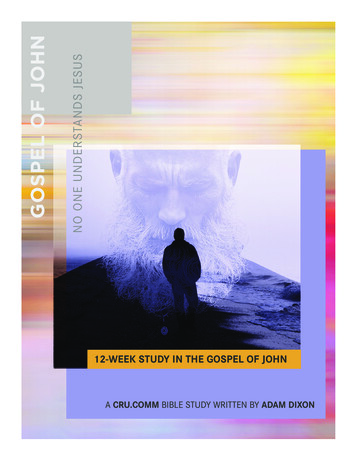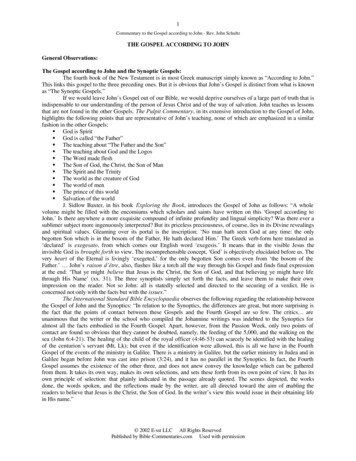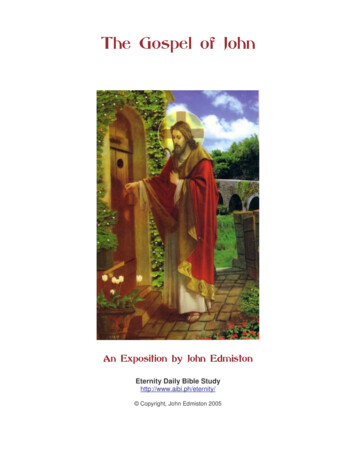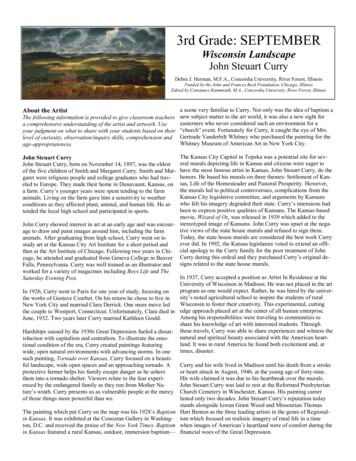
Transcription
3rd Grade: SEPTEMBERWisconsin LandscapeJohn Steuart CurryDebra J. Herman, M.F.A., Concordia University, River Forest, IllinoisFunded by the John and Frances Beck Foundation, Chicago, IllinoisEdited by Constance Kammrath, M.A., Concordia University, River Forest, IllinoisAbout the ArtistThe following information is provided to give classroom teachersa comprehensive understanding of the artist and artwork. Useyour judgment on what to share with your students based on theirlevel of curiosity, observation/inquiry skills, comprehension andage-appropriateness.a scene very familiar to Curry. Not only was the idea of baptism anew subject matter to the art world, it was also a new sight foreasterners who never considered such an environment for a“church” event. Fortunately for Curry, it caught the eye of Mrs.Gertrude Vanderbilt Whitney who purchased the painting for theWhitney Museum of American Art in New York City.The Kansas City Capitol in Topeka was a potential site for several murals depicting life in Kansas and citizens were eager tohave the most famous artist in Kansas, John Steuart Curry, do thehonors. He based his murals on three themes: Settlement of Kansas, Life of the Homesteader and Pastoral Prosperity. However,the murals led to political controversies, complications from theKansas City legislative committee, and arguments by Kansanswho felt his imagery degraded their state. Curry’s intensions hadbeen to express positive qualities of Kansans. The Kansas-basedmovie, Wizard of Oz, was released in 1939 which added to theJohn Curry showed interest in art at an early age and was encour- stereotyped image of Kansans. John Curry was upset at the negative views of the state house murals and refused to sign them.age to draw and paint images around him, including the farmToday, the state house murals are considered the best work Curryanimals. After graduating from high school, Curry went on toever did. In 1992, the Kansas legislature voted to extend an offistudy art at the Kansas City Art Institute for a short period andthen at the Art Institute of Chicago. Following two years in Chi- cial apology to the Curry family for the poor treatment of Johncago, he attended and graduated from Geneva College in Beaver Curry during this ordeal and they purchased Curry’s original designs related to the state house murals.Falls, Pennsylvania. Curry was well trained as an illustrator andworked for a variety of magazines including Boys Life and TheIn 1937, Curry accepted a position as Artist In Residence at theSaturday Evening Post.University of Wisconsin in Madison. He was not placed in the artprogram as one would expect. Rather, he was hired by the univerIn 1926, Curry went to Paris for one year of study, focusing onsity’s noted agricultural school to inspire the students of ruralthe works of Gustave Courbet. On his return he chose to live inWisconsin to foster their creativity. This experimental, cuttingNew York City and married Clara Derrick. One more move ledthe couple to Westport, Connecticut. Unfortunately, Clara died in edge approach placed art at the center of all human enterprise.Among his responsibilities were traveling to communities toJune, 1932. Two years later Curry married Kathleen Gould.share his knowledge of art with interested students. ThroughHardships caused by the 1930s Great Depression fueled a dissat- these travels, Curry was able to share experiences and witness thenatural and spiritual beauty associated with the American heartisfaction with capitalism and centralism. To illustrate the emoland. It was in rural America he found both excitement and, attional condition of the era, Curry created paintings featuringtimes, disaster.wide, open natural environments with advancing storms. In onesuch painting, Tornado over Kansas, Curry focused on a beautiful landscape, wide open spaces and an approaching tornado. ACurry and his wife lived in Madison until his death from a strokeprotective farmer helps his family escape danger as he ushersor heart attack in August, 1946, at the young age of forty-nine.them into a tornado shelter. Viewers relate to the fear experiHis wife claimed it was due to his heartbreak over the murals.enced by the endangered family as they run from Mother NaJohn Steuart Curry was laid to rest at the Reformed Presbyterianture’s wrath. Curry presents us as vulnerable people at the mercy Church Cemetery in Winchester, Kansas. His painting careerof those things more powerful than we.lasted only two decades. John Steuart Curry’s reputation todaystands alongside Iowan Grant Wood and Missourian ThomasThe painting which put Curry on the map was his 1928’s Baptism Hart Benton as the three leading artists in the genre of Regionalin Kansas. It was exhibited at the Concoran Gallery in Washing- ism which focused on realistic imagery of rural life in a timeton, D.C. and received the praise of the New York Times. Baptism when images of American’s heartland were of comfort during thein Kansas featured a rural Kansas, outdoor, immersion baptism— financial woes of the Great Depression.John Steuart CurryJohn Steuart Curry, born on November 14, 1897, was the eldestof the five children of Smith and Margaret Curry. Smith and Margaret were religious people and college graduates who had traveled to Europe. They made their home in Dunavaunt, Kansas, ona farm. Curry’s younger years were spent tending to the farmanimals. Living on the farm gave him a sensitivity to weatherconditions as they affected plant, animal, and human life. He attended the local high school and participated in sports.
Discipline-Based Art EducationThe following components are integral to students having a complete, well rounded artexperience.Art AestheticsProviding opportunities to develop perception and appreciation of visually expressedideas and experiences.Art ProductionProviding opportunities to develop skills andtechniques for creative visual expressions ofemotions and ideas.Art HistoryProviding opportunities to develop an understanding of the visual arts as a basic component of personal heritage.Art CriticismProviding an opportunity to develop anintellectual basis for analyzing and makingaesthetic judgments based on an understanding of visual ideas and experiences.ELEMENTS OF ARTLine: A continuous markShape: Area enclosed by a lineColor: Hue, reflection of light.Texture: Surface quality, real or impliedForm: 3D shape or illusion of 3DValue: Graduated areas of light/darkSpace: Illusion of depthPRINCIPLES OF DESIGNRepetition: Imagery repeating patternVariety: Contrast/variationRhythm: Issues of eye movementBalance: Even visual weightEmphasis/Economy: Dominance/minimalismProportion: Compare size relationshipsCOMPOSITIONSymmetrical: Mirrored imageryAsymmetrical: Random placementRadial: Mirror image from center pointRepetition: Repeating pattern, motifARTISTIC STYLESRealism: Realistic representationAbstraction: Personal interpretationNon-Objective: No recognizable depictionELEMENTS OF DESIGN IN PICTUREBOOKSChildren’s literature that relate to this lessondue to elements of art or story content are:Caddie Woodlawn by Carol Ryrie BrinkFrontier Farmer: Kansas Adventure byCatherine E. ChambersHard Times on the Prairie by Melissa PetersonJohn Steuart Curry: Inventing the MiddleWest by Patricia Junker, Henry Adams,Charles C. Eldredge, Robert Gamone, SueKendall, Lucy J. Mathiak, Theodore WolffTwister on Tuesday by Mary Pope OsborneThe Wizard of Oz by L. Frank BaumREFERENCE/BIBLIOGRAPHYDennis, James M. Renegade Regionalists:The Modern Independence of Grant Wood,Thomas Hart Benton, and John SteuartCurry University of Wisconsin Press. 1998Junker, Patricia. John Steuart Curry: Inventing the Middle West. Hudson Hills Press,1998.ing an ideal environment when the counAbout the Arttry was experiencing difficult times durWisconsin Landscape was painted, oil on caning the depression. In contrast to urbanvas, by John Steuart Curry in 1938-1939. Itareas where masses of people went hunmeasures 42 x 84 inches. The image is actugry or were homeless, the country offeredally a composite of several farms Curry sawopen spaces, fresh air, and food from garon his many trips around Wisconsin. Curryden or farms.painted this landscape on a very large and10. Curry also wanted to show how vulnerlong canvas (seven feet wide) to capture theable we all are to nature—something wevast space, openness of the farmland, andcan’t control. Those rolling clouds couldwide sky. Two thirds of the height is the landeasily develop into a severe storm. Peowhich is represented with a series of varyingple, animals, crops, and buildings couldcolors highlighted by the sun or caught in theall be at risk. Or, the lack of rain wouldshadow of a cloud. One third is taken up withmean crops don’t grow. What does thisthe motion-filled sky. The composition featell you about the people who chose totures a great sense of space, not only in thelive here?wide spectrum, but in the depth of the land.11. Would you like to live here? Why?We see golden hay stacks in the foreground,then the farm land, and the rolling hills in thedistance.Things to Do1. Invite individuals who lived on a farm toThe painting was executed during the Greatshare their stories of life on the farm.Depression. Although farmers felt its effect,2. Using Wisconsin Landscape as yourthey still had their land. Seeding, fertilization,guide, paint the same landscape in a difgrowth, and the harvest were signs of hope forferent season. What would it look like?those who were struggling.3. Get out in nature! Find some place whereyou can get a bird’s eye view of the land.Directed ObservationBring your cameras and take photos toShow students an image of Wisconsin Landcatch the various scenes, the ever-shiftingscape and tell them it was painted by Johnclouds and shadows on the ground. SitSteuart Curry in 1938-1939. Invite students toand sketch what you see. Use a thinquietly study the work. After some time formarker or pencil to sketch and then fill inthinking, encourage students to share whatthe color once you’re back in the classthey see. Welcome all comments. The followroom. Include objects in the foreground,ing questions are provided to help students usemid-ground, and background.art vocabulary to talk about the work.4. John Curry wanted to tell viewers a story1. Describe what you see starting in theabout the people who lived in a ruralfront (foreground) of the painting andcommunity. Study his painting and writeworking your way to the back. Be sure toa story about the people who lived in onedescribe Curry’s use of line, shape, texof the farm houses.ture, form, color, space, and value.5. Write a poem about the landscape you2. How does Curry use the elements of art toobserve. Focus on the clouds, the fields,give clues about the weather? Season?the wind, the people, the animals, theTime of day?noises you might hear or whatever else3. John Curry loved the rolling farm land ofyou notice.Wisconsin. How can you tell?6. Notice how colors in the front are more4. How would this landscape compare tovivid and colors in the background areyour town? Have you been to Wisconsin?lighter, more pale. Practice this with a5. This painting shows a typical scene insome watercolor paint. With lots of waterWisconsin, although there are other typesand little blue or green paint, create a rowof places (cities, suburbs) in Wisconsinof hills near the top of the paper. Let dry.than farm communities.Add a bit more paint to the brush and6. Map out 42 x 84 inches. This is a largemake a new row of hills beneath the firstpainting. Discuss the benefits of such arow. Eventually, flatten out the hills tolarge canvas when painting a landscape.make fields. Your colors should be more7. Using the principles of organization, dissaturated at this point. When dry, addcuss how Curry organized his composidetails such as trees, river, lake, buildtion. (Repetition, variety, rhythm, balings, people and animals.ance, emphasis/economy, and proportion) 7. Curry felt the landscapes of Wisconsin8. Share John Curry’s background, espewere beautiful. What beautiful landscapescially his time in Kansas and the negativehave you seen? Tell where they were andreviews of his murals.then describe the beauty you saw. Draw a9. John Curry was very interested in paintpicture of the landscape.
3rd Grade: OCTOBERImprovisation 31 (Sea Battle)Wassily KandinskyDebra J. Herman, M.F.A., Concordia University, River Forest, IllinoisFunded by the John and Frances Beck Foundation, Chicago, IllinoisEdited by Constance Kammrath, M.A., Concordia University, River Forest, Illinoiscredited with advancing the study of art. They opened a newschool and brought Monet’s art to Munich for the first time in1903. During this time period, Kandinsky separated from his wifeand later divorced. Eventually he met German-American artist,Gabriele Munter, who became his mistress. They traveledthroughout Europe and North Africa and settled in Paris in 1906.Two years later they relocated to Munich where Gabriele purchased a country house. Kandisky used this location to bring toWassily Kandinskygether like-minded artists, composers, and playwrights whoVasili (Wassily) Kandinsky was born on December 4, 1866, inwished to work collaboratively. The major impact of his careerMoscow, Russia. He was raised in a loving, upper middle-classduring these years was painting some of his popular landscapeshome by his father, a successful tea merchant, and his mother, ateacher. He enjoyed the German fairy tales his mother and grand- and experimenting with non-objective painting by replacing amother told him as well as family trips to such places as Venice, representational object with expressive color and form. In 1910,Rome, and Florence. While on a trip to Europe in 1871, Kandin- Kandinsky exhibited his works in Odessa and Moscow, contributed to the production of an artist’s publication titled the Blauesky’s father fell ill and forced the family to return to the smallRussian town of Odessa. Although his father recovered, Kandin- Reiter Almanach (Blue Rider Almanac) in which he shared artsky’s parents soon divorced and the young lad was raised by his ists’ aesthetic ideas and inspirations, and published Uber dasFeistige in der Kinst (On the Spiritual in Art), a significant docufather and aunt. Kandinsky managed to complete his schoolingthrough high school and learned to play the piano and cello. This ment on the theory of non-objective art.music was important to Kandinsky and served as the foundationfor some of his abstract paintings. Painting, however, was a mere When World War I was declared in 1914, Kandinsky and hismistress left Munich, Germany, for Switzerland. Within months,hobby during his early years.Kandinsky had left his mistress and returned to Moscow wherehe eventually married a wealthy Russian woman, Nina AnIn 1886, the twenty-year old Kandinsky moved to Moscow todreevskaja who was twenty-seven years younger than Kandinsky.study law and economics at Moscow University. As a good stuIt is said they first met by phone and he was so impressed withdent, he earned a degree equivalent to a doctorate and secured aher voice, he painted a watercolor titled, To the Unknown Voice.university faculty position. On a visit to a French Impressionistexhibition in Moscow, Kandinsky was surprised and troubled by They had one child, a son, who died at age three from undernourishment during the Civil War in Russia. Kandinsky taught atthe way artists such as Claude Monet painted objects as barelyMoscow’s Institute for Visual Arts, was Director of Public Museidentifiable for he had never seen this before. Color and lightwere the subject and the representational object was absent. This ums, and taught art theory at the University of Moscow. Later,Kandinsky moved back to Germany to become an instructor atepiphany was a great inspiration and motivation for Kandinsky.the Bauhaus School of Art and Architecture where he developedKandinsky married his cousin, Anja Chimiakin in 1892. When at and published his aesthetic principles. He and his wife Nina became German citizens.age thirty, Kandinsky was offered a new teaching position andchairmanship at the University of Dorpat in Estonia, he was facedThe rise of the Nazi regime threatened Kandinsky and the supportwith a tough decision—to stay in the world of academia or venture on a new path. Kandinsky decided to shift his attention to art. for art and the Bauhaus was officially closed by the Nazi regimeHe left the position at Moscow University, declined the position in 1933. Kandinsky and Nina moved to France and settled inat the University of Dorpat, left his marriage to Anna Chimiakina Neuilly-sur-Seine near Paris, adopting French citizenship in1939. He continued working until his death on December 13,and enrolled at the private school of Anton Ažbe and then theAcademy of Fine Arts in Munich in Southern Germany with the 1944, at the age of seventy-eight. After his death, Nina foundedthe Kandinsky Fund for studying, exhibiting and preserving herintention of becoming a painter.husband’s work. Kandinsky is remembered as one of the mostoriginal and influential artists of the 20th century for the developHaving rejected his bourgeois life, Kandinsky had to adjust to ament of abstract painting.new life for which his years as a professor left him a bit out ofplace. He earned a diploma and a reputation as a competent artistfrom the Munich Academy with an interest in contemporaryAbout the Arttrends. He was the founding member of an artist’s organizationImprovisation 31 (Sea Battle), was painted in 1913, oil on can-About the ArtistThe following information is provided to give classroom teachersa comprehensive understanding of the artist and artwork. Useyour judgment on what to share with your students based on theirlevel of curiosity, observation/inquiry skills, comprehension andage-appropriateness.
Discipline-Based Art EducationThe following components are integral to students having a complete, well rounded artexperience.Art AestheticsProviding opportunities to develop perception and appreciation of visually expressedideas and experiences.Art ProductionProviding opportunities to develop skills andtechniques for creative visual expressions ofemotions and ideas.Art HistoryProviding opportunities to develop an understanding of the visual arts as a basic component of personal heritage.Art CriticismProviding an opportunity to develop anintellectual basis for analyzing and makingaesthetic judgments based on an understanding of visual ideas and experiences.ELEMENTS OF ARTLine: A continuous markShape: Area enclosed by a lineColor: Hue, reflection of light.Texture: Surface quality, real or impliedForm: 3D shape or illusion of 3DValue: Graduated areas of light/darkSpace: Illusion of depthPRINCIPLES OF DESIGNRepetition: Imagery repeating patternVariety: Contrast/variationRhythm: Issues of eye movementBalance: Even visual weightEmphasis/Economy: Dominance/minimalismProportion: Compare size relationshipsCOMPOSITIONSymmetrical: Mirrored imageryAsymmetrical: Random placementRadial: Mirror image from center pointRepetition: Repeating pattern, motifARTISTIC STYLESRealism: Realistic representationAbstraction: Personal interpretationNon-Objective: No recognizable depictionELEMENTS OF DESIGN IN PICTUREBOOKSChildren’s literature that relate to this lessondue to elements of art or story content are:A Door to Your Imagination by Heath andIam KnightKandinsky Take Off: Life and Work by PaulFluxNavel Battle of the Civil War by Peter F.CopelandSticker Art Shapes: Vassily Kandinsky,Frances Lincoln Children’s BooksREFERENCE/BIBLIOGRAPHYAbrams, Harry H. Wassily Kandinsky: Lifeand Work. New York. 1958Barnett, Vivian Endicot. Kandinsky: Watercolors and Crawings (Art & Design). CornellUniversity Press. 1994Hughes, Robert. American Visions, TheEpic History of Art in America. Alfred A.Knopf, Publisher, New York. 1997Kandinsky, Wassily. Concerning the Spiritual in Art. Translated by M.T. Sadlervas. It is 57 x 47 inches and is at the NationalGallery of Art in Washington D.C.2.The title of his work, Improvisation 31 contains the subtitle of Sea Battle which gives ahint to the imagery. While it’s not overtly obvious, one can easily imagine ships shootingcannonballs at each other and experience thechaos and motion of battle on the sea. Kandinsky imitates battle through the use of colorsplaced roughly and angled on the canvas.Smeared and smudged paint adds to the feel ofmotion and action. The use of strong verticaland diagonal lines references masts and sailson a boat.3.Directed ObservationShow students an image of Improvisation 31(Sea Battle) and tell them it was painted withoil paint on canvas by Wassily Kandinsky in1913. Invite students to quietly study thework. After some time for thinking, encouragestudents to share what they see. Welcome allcomments. The following questions are provided to help students use art vocabulary to4.talk about the work.1. Artists’ styles include realism, abstractionand non-objectivism. Realism is when thesubject matter looks just like the real object. Abstraction is when you can stillidentify the subject matter but it is stylized. Non-objectivism is when the subjectmatter can’t be identified. Kandinskypainted Improvisation 31 (Sea Battle) asan abstraction. Although a bit obscure,the abstracted image of a sea battle can beidentified in Kandinsky’s painting.2. Do you like realistic work or abstractwork better? Which is harder to make?3. Kandinsky’s intention was to capture theemotion of a sea battle. What emotionsare connected with a battle at sea?4. Describe how Kandinsky used color andlines to achieve those emotions.5. Describe how your eyes move around thepainting. Where do they start?6. What did the artist place in the painting toredirect your eyes around the work?7. How does this eye movement make thework successful?8. Why is eye movement especially important in a painting that is about a battle?9. Why do you like/not like this painting ?Things to Do1.Wassily Kandinsky was a very smart andwell-educated man who worked hard atunderstanding art. He struggled betweenpainting realistic images and abstracts ofthe real. In the end, he felt he could betterrepresent the object or scenery by concentrating on the emotion of what he saw.Think about the following items or actions and describe what emotion(s) cometo mind: car, pet, grandparent, pizza,skateboard, favorite movie or song, favorite friend, roller coaster ride, skateboardexperience, a sporting event, or a roadtrip. Use one of the above and describehow you would paint the emotions itevokes. Choose one of the items or actions listed or name a new one and createan abstract painting. Remember, an abstract painting makes reference to theactual item. You may want to sketch theitem or action and then shift it into anabstract work using colors and lines.Kandinsky loved music and drew greatinspiration from the melody and movements within a musical work. He alsorelated the ability music has to evokeemotion to art. Close your eyes and listento various types of music. With a thickblack marker in hand, react to the musicby making marks on a large piece of paper. Add a watercolor, tempera, or acrylicpaint around the black lines.Would a painting be art if you couldn'trecognize anything in the painting?Would a painting be art if it were onlylines and shapes? These are the questionswhich inspired Kandinsky’s work. Hiswork is about letting go of conventionalthoughts about art. Use the followingactivity for a collaborative experience in“letting go.” Divide the classroom intogroups of three. Give each student a largepiece of paper or tagboard (16 x 20”).With a pencil, lightly divide the paperinto six even sections. With a blackmarker, have each student create a line inone section of the paper. Then, pass theirpaper to the next person in the group tocreate an interesting line on theirneighbor’s paper. Continue to pass thepapers around the group until all the sections have a line. (Lines can intersect.)Repeat the process of passing their papers. This time have group members create a shape in each section. (Shapes canintersect.) Shift to oil pastels or crayons.Working with their own papers, have students color in and alongside the lines andshapes, blending colors, until the entirepaper is filled in. Once completed, framethe work in a white mat using posterboard and display work for all to see. Allow students to discuss the finished workby comparing and contrasting what theysee. Discuss the process of “letting go” oftheir work. How did they feel about it?What was the risk involved? Did it improve the final work and the ability toexperiment? Title and exhibit the work.
3rd Grade: NOVEMBERThe Blind GirlJohn Everett MillaisDebra J. Herman, M.F.A., Concordia University, River Forest, IllinoisFunded by the John and Frances Beck Foundation, Chicago, IllinoisEdited by Constance Kammrath, M.A., Concordia University, River Forest, IllinoisAbout the ArtistThe following information is provided to give classroom teachersa comprehensive understanding of the artist and artwork. Useyour judgment on what to share with your students based on theirlevel of curiosity, observation/inquiry skills, comprehension andage-appropriateness.John Everett MillaisJohn Everett Millais was born on June 8, 1829, to John Williamand Emily Mary Millias. Both parents were from prosperousfamilies. Millais was born in Southhampton, England, but hisfamily moved to the English town of Jersey and then on to London when Millais was nine years old. Young Millais loved tosketch at an early age and showed much talent. He attendedschool but was not really interested in studying, so his mothertook over his formal education. Millais’ interest in art continuedand he exhibited talent that gave him impressive status. Themove to London was to support his artistic education.including works of Lord Alfred Tennyson and John Keats, becoming a storyteller in a visual form, painting instinctively andcapturing the drama of the story.The degree of Millais’ success was due partly to the support ofthe foremost art, stage and social critic of the day, John Ruskin.Ruskin met Millais when he defended one of Millais’ paintings.Millais accompanied Ruskin and his wife, Euphemia (Effie) on afour month holiday to Scotland with the intention of painting twoportraits; one of Ruskin and one of Effie. During this time, Millais and Effie became attracted to each other. The relationshipgrew over time and Effie eventually left her marriage. She wasgranted an annulment since her first marriage had never beenconsummated. The entire affair raised a huge scandal in Englandknown as the Victorian Love Triangle. Millais and Effie weremarried in 1855 and were blessed with eight children. She frequently modeled for Millais who captured her beauty.Millais’ previous work had been focused on capturing naturewith great attention to detail. Following his marriage to Effie andthe birth of his children, Millais ventured into a different style.He no longer had the time to devote months to painting detailmeticulously. He needed to produce more income in shorter periods of time. He painted with looser strokes and in a more impulsive style. Naturally, Millais’ new style was not well received bymany who had been Pre-Raphaelites. Whatever the opinion, Millais managed to build his reputation as one of the most successfulportrait painters. He was able to brilliantly capture the likeness aswell as the character of the individual. His business grew andwith it, his financial success, providing the family with a grandWhile at the Royal Academy, Millais connected with two otherartists who shared ideas regarding the mechanically produced art house in Kensington, England. Along with his wealth and fame,of the time. In their opinion, the art was sub-standard and focused Millais had great pride in his appearance. His self-portraits werepainted mostly in profile to capture his exceptional good looks.on materialism consistent with the Victorian era. Together, theyformed a group in 1848 and called it the Pre-Raphaelite BrotherIn 1892 Millais’ health began to fail. He suffered from influenzahood. This brotherhood served to support those who wished topursue art but had no formal training. The name comes from the and a subsequent swollen throat which proved to be cancerous,artist Raphael who, in the group’s opinion, created the most ideal probably from his constant pipe smoking. In 1896, Millais waspaintings. They developed a list of four objectives for their work: elected President of the Royal Academy and in August of thesame year, he died at the age of sixty-seven. He is buried at St.1. To have genuine ideas to express;Paul’s Cathedral in London.2. To study Nature attentively, so as to know how to expressthese ideas;About the Art3. To sympathize with what is direct and serious and heartfeltin previous art, to the exclusion of what is conventional and The Blind Girl was painted in oil on canvas in 1856 when theartist, John Everett Millais, was twenty-seven years old. It is inself-parodying and learned by rote;4. And, most indispensable of all, to produce thoroughly good the Birmingham Museum and Art Gallery, West Midlands, England. The canvas is 32 x 24 1/2 inches. Millais painted The Blindpictures and statues.Girl while he and his wife were visiting her hometown of Perth,Scotland. The two young girls in the painting were MatildaJohn Everett Millais became very successful painting accordingto the four objectives. He was often inspired by poems of the day Proudfoot and Isabella Nickol. Effie Millais was the actual bodySir Martin Archer Shee, President of the Royal Academy, sentyoung Millais to Henry Sass’s private art school and then to theBritish Royal Academy at age eleven. His nickname, the child,was bestowed on Millais since he was the youngest to ever attendthe academy. Despite his youth, the curly-headed Millais rose tohis callin
times, disaster. Curry and his wife lived in Madison until his death from a stroke or heart attack in August, 1946, at the young age of forty-nine. His wife claimed it was due to his heartbreak over the murals. John Steuart Curry was laid to rest at the Reformed Presbyterian C

